Genus
Bujurquina
Text and photos by Alf Stalsberg,
unless otherwise indicated.
CLICK ON ANY IMAGE TO ENLARGE IT
Bujurquina "peregrinabunda", Kullander 1986
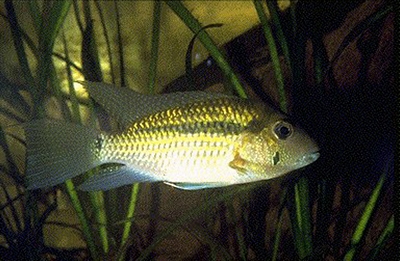 |
Bujurquina "peregrinabunda". |
The fish was, as the heading says, described by Dr Kullander in 1986 from Peru. This year when he made this new genus, he described 12 new Bujurquina all from Peru. Bujurquina syspilus was already described by Cope, 1872 as Acara syspilus.
Fishes in the genus Bujurquina are not so easy to separate from each other. But there are differences in the shape and the stripe or spot on the lower part of the cheek. We can't say there are big differences in the color. The fish in the photo was collected in Ecuador in 1987, and checking with Dr Kullanders book "Cichlid fishes of the Amazon drainage of Peru" 1986, made me think this was Bujurquina perigrinabunda. When I spoke with Dr Kullander, who had received conserved material of the fish, he said everything seems to match his description of Bujurquina perigrinabunda, except for one thing. My fish had small green dots on the cheek, but the fishes in the material he based his description on did not have this. So in the meantime, until this is cleared up, I use quotation marks on the name "perigrinabunda".
The Bujurquinas are called delayed mothbrooders. It's because the fish spawn in a manner like the substrate spawners. In their natural environment they usually prefer to spawn on leaves.
Here you see the Bujurquina sp. with eggs on an oak leaf. |
|
This gives the fish some advantages. If the fish feels insecure, it takes the leaf with eggs on and transports it to a safer place. If the water level in the river suddenly drops too, the fish can carry the eggs out to deeper water.
The eggs hatch after 48 hours and then one of the fish, usually the female in the beginning, picks up the newly hatched fry and takes them into her mouth. This job is shared by both fish. When you feed them, one of the fish eats first, then the other fish spits out the fry on the sand in front of the other, who takes the fry up into the mouth.
This goes on for about one week, then the fry are ready for the world. Click on the photo and you will see how the fry wanted to get into the mouth because they were scared when I came with the camera.
Bujurquina sp. vittatus
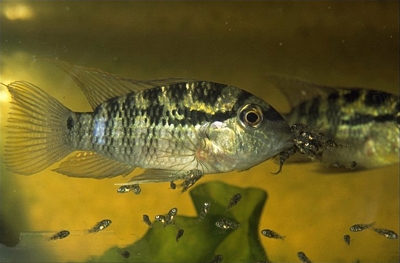 |
Bujurquina sp. vittatus with fresh fry out, and the fry trying to get in the mouth when I show up with the camera. |
I feed the fry with newly hatched brine shrimp. After about a week, I start feeding them with some crushed flake food too. When they are scared the fry will try to get into the mouth of one of the parent fish. But after about a week the parents can't get all the fry into their mouth, so they just guard them like ordinary substrate spawners.
This behavior goes for all the Bujurquinas, and this is a fish I highly recommend. You might not often find species of Bujurquina in the shops, but if you do, buy them.
Bujurquina sp. Bolivia
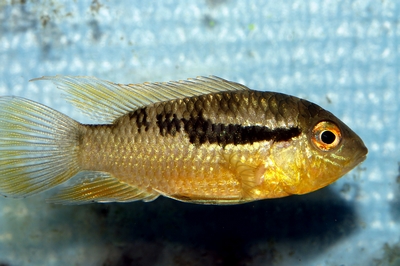
ABOVE: Female Bujurquina sp. Bolivia. |
BELOW: Male Bujurquina sp. Bolivia with fry in mouth,
notice the swollen throat.
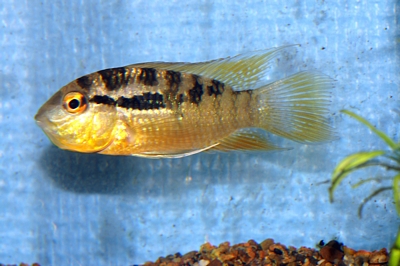 |
Bujurquina oenolaemus comes from Bolivia, most of the Bujurquina are described from Peru, but there are several in Colombia, Ecuador and also in other countries. I think there are more to come.
The fish is rather easy to keep. Good water quality, a good diet and a temperature of around 26°C.
Here are some fry that have been out for about a week. They are not taken up in the mouth anymore. I feed them with newly hatched brine shrimp. |
|
Bujurquina apoparuana
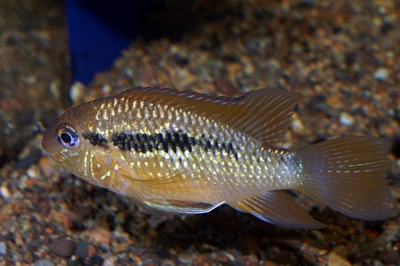
Different views of Bujurqina apoparuana males. |
These males are not fully adult, they are about 6 cm.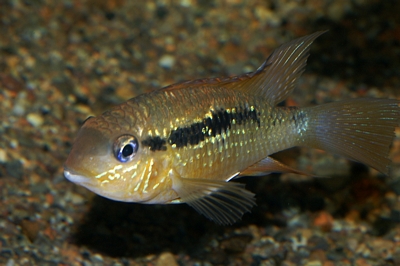 |
Bujurquina are not the most colorful of fish, but they are still nice and interesting.
Bujurquina sphenozona
Bujurquina sphenosona is more gray in color and does not have a particular color on the body.
 |
. |
MORE INFO ABOUT Bujurquinas will come.
Cichlid Power,
Alf
DISCLAIMER: Statements made on this page are not herewith made available for the purpose of zoological nomenclature
under the International Code of Zoological Nomenclature.
Copyright 1995- Alf Stalsberg – Cichlid Power